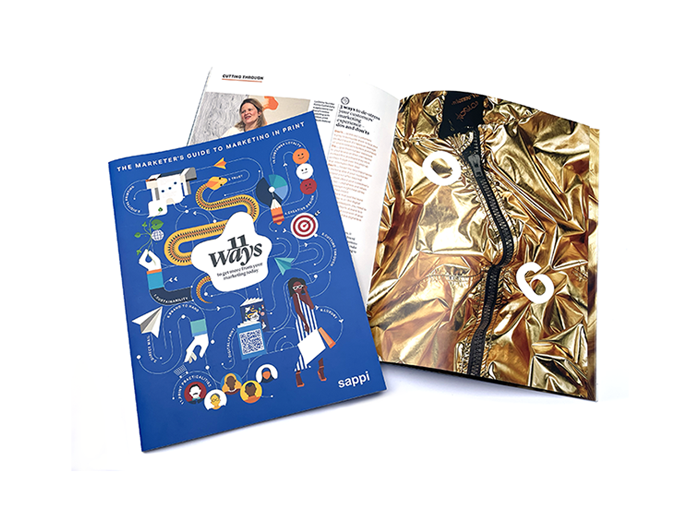Print's Trust Power: Tangibility and Authenticity
“Earn trust, earn trust, earn trust. Then you can worry about the rest”

Well said, Seth Godin. But trust is a fragile commodity. According to the 2022 Edelman Trust Barometer, almost six in 10 people say their default tendency is to distrust – until they see evidence to the contrary.
To most brands, the importance of trust is nothing new. When Sappi commissioned global data consultancy Kantar to survey 1,200 marketing specialists across Germany, Spain, France, Italy, the UK and the US, more than 80% of participants labelled trust as an essential brand attribute. Meanwhile, according to a 2019 survey by Stackla, covering the US, UK and Australia, authenticity is important to 90% of consumers when they’re deciding which brand to support.
To build and strengthen consumer trust, brands need to treat customers well and deliver on their promises. And they need to communicate what they’re doing – which is where print can be more effective than digital.

According to our Kantar survey, print is seen as four times more trustworthy than social media. And those figures are backed up by other sources. The UK’s Royal Mail reported that 87% of recipients consider mail to be believable, compared to just 48% for email. Not only that, but a report by marketing advisory company WARC, in association with Royal Mail Marketreach, revealed that trust in addressed mail actually increased in 2020, while trust in digital advertising decreased.
Perhaps it’s partly the physicality of print that makes it more trustworthy. We’re more likely to believe in something we can touch, smell (and even taste for some campaigns) than a digital image. Holding something in your hands (like you are now) feels tangible. It can’t just be altered or deleted. And this holds true even for today’s screen-savvy digital natives – according to research by Royal Mail Marketreach, 15-24 year-olds are more likely to trust physical mail than any other age group.
Meanwhile, recent years have seen scandal after scandal regarding digital data privacy. Combine that with phishing emails and social media scams, and it’s no wonder that today prospects and consumers are (rightly) wary of clicking on links. Print can feel like a more trustworthy, safer option.

No surprise, then, that a Paper Reach survey in Belgium in 2020 found that almost 47% of people will take action after receiving printed mail. While a 2021 intervista AG survey in Switzerland found that 48% say they pay attention to addressed promotional mail, compared to just 18% for online adverts.
And it’s not just consumers who are becoming more and more wary of their digital interactions. As the Harvard Business Review noted recently, “Marketers are becoming sceptical of the hyped returns of digital media, because the platforms control both the advertising inventory and its effectiveness measurement. This has raised credibility concerns related to ad fraud and the worry that digital advertising may be far less effective than reported.”
Print, meanwhile, has the added power to make both prospects and existing customers feel more appreciated. According to WARC, people are twice as likely to feel valued by printed mail as they are by email – and twice as likely to be left with a positive feeling towards the sender. That Belgian Paper Reach survey found that 59% of direct mail generates a positive emotion (while only 6% results in a negative emotion).
At the same time, people are far more likely to trust people over brands, which is why influencer marketing has become so high profile – and why it’s crucial to build an emotional connection with your target audience. And emotion is another area where print shines.
A study by Millward Brown in the UK found that just picking up a printed piece of paper activates the cerebellum – the part of the brain associated with spatial and emotional processing. And according to the Marketing Society, mail gives 70% of recipients a better impression of a brand.
Likewise, a strong brand voice is crucial to maximising the sense of a human connection. A 2018 study by researchers at Neuro-Insight for Royal Mail Marketreach found that mail is 49% more memorable than email – and 35% more memorable than social media advertising. Done well, it can also result in real-life sharing. According to the UK’s Joint Industry Committee for Mail (JICMAIL), 14% of addressed mail prompts a household conversation.
Three ways print can help you build brand credibility
1. Act like a human – send a postcard
As the article here highlights, print has the power to make prospects and customers feel appreciated – and that can have powerfully positive connotations for your brand. You don’t have to go so far as to emulate Swiss Post’s RoboPen service by making your postcards appear handwritten, it really is the thought that counts. Let someone know your brand is thinking of them – and put a three-dimensional example of your branding and brand message directly into their hands.
2. Look the part – display some great comms
Anything you put together in print for your brand should look the part, so be sure to invest in good graphic design and clear, concise copywriting. And then let anything from a point-of-sale poster to a door-dropped flyer to a mailed-out customer magazine offer your customers interesting and useful content – and show them why your brand is worth paying attention to.
3. Share your knowledge – put together a white paper
Something usually only associated with bigger brands, there’s no reason why medium-sized or smaller businesses shouldn’t get in on the act. It’s all a question of choosing your niche, defining your expertise and putting a little effort into sharing your knowledge – be that in the form of a multi-chapter white paper (or series of white papers) that you send out to key customers, or just a ‘how-to’ pamphlet to help people make the most of the commercial space in which your product offer lives.
Holding something in your hands feels tangible. It can’t just be altered or deleted



